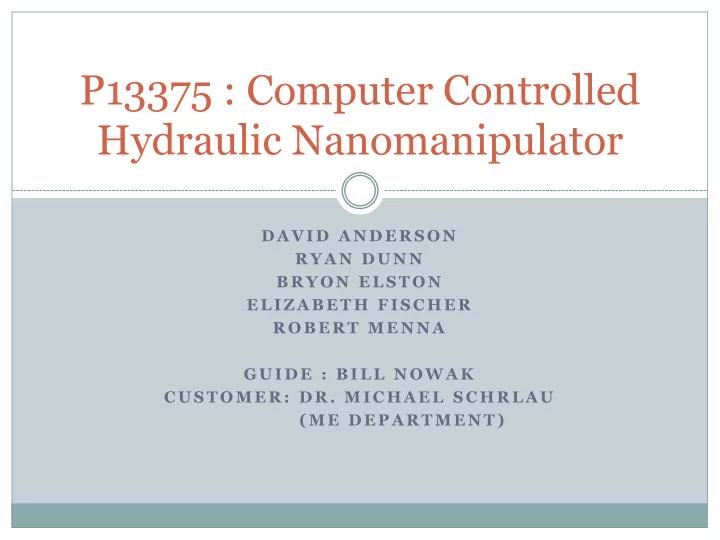

P13375 : Computer Controlled Hydraulic Nanomanipulator D A V I D A N D E R S O N R Y A N D U N N B R Y O N E L S T O N E L I Z A B E T H F I S C H E R R O B E R T M E N N A G U I D E : B I L L N O W A K C U S T O M E R : D R . M I C H A E L S C H R L A U ( M E D E P A R T M E N T )
Main Focus of Improvements Reduce Backlash Increase Speed Provide Remote Access Capabilities Stop System Leakage Issue
Design Concept (Mechanical) Cont.
Engineering Specifications Specification Unit of Target Theoretical Actual Previous # (metric) Measure Value Value Value System S1 Size of manipulator cm 8 x 8 x 8 13 x 12 x 12 13 x 12 x 12 13 x 13 x 13 (h x w x l) S2 Weight of Grams 550 400 400 689 manipulator S3 Development cost $ 1,352 1,441.81 1,441.81 2,128 S4 Cost to manufacture 1000 - $ 1,413.01 1,413.01 1,470 after development 1500 S5 Limits of travel in cm >0.25 0.5 0.5 1.1 each direction S6 Speed of travel mm/sec 0.5 .088 0.0392 0.04 S7 Observed Eppendorf nm < 100 86.74 1601 Resolution 500 Theory Resolution nm <100 86.74 14 56 (From Speed) S8 Sampling Rate Hz 60 0 60 NA S9 Level of Difficulty of Binary Easy Easy Easy Medium Use
Engineering Specifications Continued Specification Unit of Target Theoretical Actual Previous # (metric) Measure Value Value Value System S10 Supported Control Binary Yes Yes Yes Yes Software S11 Visual Feed Hz 60 60 60 NA Sampling Rate System is Controlled by a S12 Binary Yes Yes Yes Locally Device (Remotely and Locally) S13 System Provides Additional Feedback Subjective Yes Yes Yes No S14 System Provides Binary Yes Yes Yes No Calibration Revolution S15 System Backlash <3 0 2.27 25 s Frames Per S16 Video Latency >30 30 30 NA Second S17 Control Latency ms <200 200 ~100 NA
Speed Testing Find current and desired coordinates based on current position Drive the motor in desired direction Stop motor so as to approach desired coordinates Measure actual end coordinate Calculate speed based on time given by Matlab stopwatch function: “tic” and “ toc ” Functions tic and toc run at start and stop commands; respectively
Speed Eppendorf Eppendorf Speed (um/s) CQS Forward CQS Reverse Forward Reverse X Axis 0.0392 0.0240 2045 Y Axis 0.0150 0.0197 Z Axis 0.0060 0.0062 A stiffer return spring in x would improve reverse speed Stabilizing system would also improve speed Also should be noted that backlash does impact speed
Backlash Two observers Observer 1: Camera Feed Observer 2: Motor Rotation Observer 1 ran the motors until motion was observed and Observer 2 reported number of revolutions Backlash Eppendorf Eppendorf Summary (rev) CQS Forward CQS Reverse Forward Reverse X Axis 0.50 0.75 Negligible Backlash Y Axis 3.38 3.58 Z Axis 2.92 2.50
Resolution Testing A Matlab function was created to “step” the motors at speed 300/1000 for a period of 3 seconds The motors were “stepped” repeatedly until a distinctly different location was observed Matlab applied unscaled axes to the image Conversion from Matlab Scale to Microscope: Used ruler slide to find the conversion (see next slide) Testing done at 40x
Resolution Testing (Scaling) 731.6 762.18 pixels = 0.1 mm = 100 μ m 548.7 7.6218𝑞𝑦 × 1000𝑜𝑛 1𝜈𝑛 #𝑜𝑛 = #𝑞𝑦 × 1𝜈𝑛 365.8 182.9 0 0 182.9 365.8 548.7 731.6 914.5 1097.4 1280
Resolution CQS Eppendorf Resolution (nm) Resolution (nm) X 1601 500 Y 4325 ~33 px ~12 px
Items Still in Progress User’s Manual Update Information on Edge
Suggestions for Future Work Further improve method of securing nanomanipulator (still using magnetic stand) Improve system resolution Improve carriage “wobble” – possibly use ball bearing tracks
Eppendorf Software Update Eppendorf control implemented 2 versions (Eppendorf, Generic) Debug, comment and document Demonstration or Video?
Eppendorf Future Work Merge software forks into 1 package Make networked vs. local an option Consult with Nick to compare and commit changes
Lessons Learned Dealing with Suppliers Discuss items for purchase with the company’s engineers, not just sales Communication regarding small quantities can be difficult Give suppliers a sense of the future of your project – can help with discussion regarding quotes ALWAYS follow up on any request for information or product Importance of risk management Need to have multiple back up plans If not impractical, take time early on to recreate prior results – especially in specs you are seeking to improve Machining ALWAYS takes longer than expected
Acknowledgements The team would like to thank the following individuals for their help and guidance throughout this project. Guide: Bill Nowak Customer: Dr. Schrlau Charlie Tabb Nicholas Hensel Team P13371 Team P12371 Tim Patane of Component Supply
QUESTIONS?
Recommend
More recommend